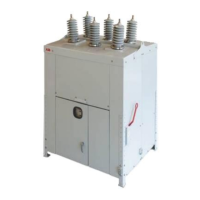2. CONTROL BOARDS AVAILABLE/MAGNETIC ACTUATOR
COIL ENERGIZING CAPACITOR
1. Low voltage full optional board (17 – 75 VDC or 20 – 52 VAC).
2. High voltage full optional board (77 – 280 VDC or 85 – 264 VAC).
3. 0.1 farad aluminum electrolytic capacitors.
3. BINARY INPUTS
There is a removable filter card plugged into the control board. This filter card has five metal
jumpers on the board. When these jumpers are cut the binary input threshold is raised by 20
Volts. It is recommended that these jumpers are cut for 125VDC applications.
Binary input channels work properly with a voltage range of 24 to 264 VAC/DC regardless of
which board is used. All inputs have a low threshold at about 18 VDC and 19 VAC with the
exception of the Protection Relay input, which has a low threshold of 7 VDC. To avoid false
triggering by noise, the inputs must be active for at least 6 milliseconds. The current draw for
most inputs is < 2 milliamperes. The exception is the Remote Open and Remote Close inputs,
which draw up to approximately 20 milliamperes. The input impedance (Z) is 300kΩ except for
binary inputs 1 and 2 (Remote Open and Remote Close) which are around 14 kΩ input Z.
There are seven different input channels. Only six of them are used for the R-MAG breaker
(channel 5 is not used).
3.1 Remote Close (KM1005, CH 1, Pins 1 and 2)
The Remote Close input is used to close the breaker remotely. The input impedance is approxi-
mately 15 kΩ.
3.2 Remote Open (KM1005, CH 2, Pins 3 and 4)
The Remote Open input is used to trip the breaker remotely. The input impedance is
approximately 15 kΩ. When tripping with electro-mechanical relays, an additional resistor will be
required to drop the trip flags.
3.3 Auxiliary Open / Safe Open (KM1005, CH 3, Pins 5 and 6)
This input can be configured as either an Auxiliary Open function or a Safe Open function. The
position of dip switch I1002-1 determines which is selected. If it is Off, it is used as Auxiliary. If
the dip switch is On, it is used as Safe Open.
The Auxiliary Open functions the same as the Remote Open function, with the exception of the
input impedance which is approximately 300 kΩ.
The Safe Open function allows the user to open the circuit breaker when the on-board
microcontroller is faulty. During normal conditions, all opening inputs work, but if the
microcontroller is damaged, only the Safe Open input can perform the opening command. When
the microcontroller is damaged, capacitor monitoring is not active so other inputs will be

